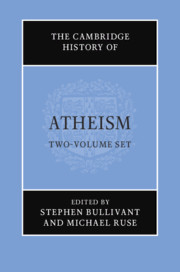Book contents
- The Cambridge History of Atheism
- The Cambridge History of Atheism
- Copyright page
- Dedication
- Contents
- Acknowledgments
- Contributors
- Introduction
- Part I Preliminaries
- Part II Atheisms in History
- Part III Reformation, Renaissance, Enlightenment
- Part IV Classical Modernity: Philosophical and Scientific Currents
- Part V Classical Modernity: Social and Political Currents
- Part VI Twentieth and Twenty-First Centuries: Intellectual and Artistic Currents
- Part VII Lived Atheism in the Twentieth- and Twenty-First Centuries: Case-Studies
- Part VIII Emerging Atheisms in the Twenty-First Century
- 54 New Atheism
- 55 The Internet and the Social Media Revolution
- 56 The Atheist Spring? Emerging Non-belief in the Islamic World
- 57 Intersectional Atheisms: Race, Gender, and Sexuality
- 58 Religion for Atheists? Transhumanism, Mindfulness, and Atheist Churches
- 59 Atheism Throughout the World
- Part IX Conclusion
- Index
- References
55 - The Internet and the Social Media Revolution
from Part VIII - Emerging Atheisms in the Twenty-First Century
Published online by Cambridge University Press: 25 September 2021
- The Cambridge History of Atheism
- The Cambridge History of Atheism
- Copyright page
- Dedication
- Contents
- Acknowledgments
- Contributors
- Introduction
- Part I Preliminaries
- Part II Atheisms in History
- Part III Reformation, Renaissance, Enlightenment
- Part IV Classical Modernity: Philosophical and Scientific Currents
- Part V Classical Modernity: Social and Political Currents
- Part VI Twentieth and Twenty-First Centuries: Intellectual and Artistic Currents
- Part VII Lived Atheism in the Twentieth- and Twenty-First Centuries: Case-Studies
- Part VIII Emerging Atheisms in the Twenty-First Century
- 54 New Atheism
- 55 The Internet and the Social Media Revolution
- 56 The Atheist Spring? Emerging Non-belief in the Islamic World
- 57 Intersectional Atheisms: Race, Gender, and Sexuality
- 58 Religion for Atheists? Transhumanism, Mindfulness, and Atheist Churches
- 59 Atheism Throughout the World
- Part IX Conclusion
- Index
- References
Summary
The British journalist Andrew Brown once joked that a typical atheist organization consists of three men and the website. Although the joke exaggerates and oversimplifies the situation, it captures something real about atheism in the twenty-first century. Men are more likely to be atheists, and they are also more likely to be members of atheist organizations. Furthermore, such organizations typically have a small number of members, but their presence in the public sphere and significance for individuals tend to be notable. Moreover, the joke underlines the importance of the Internet for the existence and visibility of contemporary atheism.
- Type
- Chapter
- Information
- The Cambridge History of Atheism , pp. 1024 - 1039Publisher: Cambridge University PressPrint publication year: 2021
References
- 2
- Cited by

